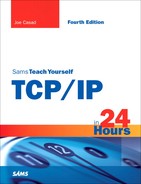Multimedia Links
You don’t have to surf far to find video and audio images embedded in web pages. Click a link to hear a sound, watch video, or listen to a vocal track. You might be wondering what is actually happening with you click that link.
The answer, of course, depends on where the link goes. Many multimedia links are simply files. As you learned earlier in Hour 17, “HTTP, HTML, and the World Wide Web,” an <a> tag with an HREF attribute is a reference to another resource. In previous examples, that resource was a web page. However, the reference can point to any type of file as long as the browser knows how to interpret the file’s contents. Modern browsers can handle many different types of file formats. On Windows systems, the file extension (the part of the filename after the period, such as .doc, .gif, or .avi) tells the browser (or the operating system) what application to use to open the file. Some other operating systems can determine the file type independently of the file extension. If the browsing computer has the necessary software to open the video or audio file, and if the browser or operating system is configured to recognize the file, the web page can reference the file through an ordinary link, and the browsing computer will execute the file when the link is clicked.
Common video file formats include
.AVI (Audio Visual Interleave)— An audio/visual format developed by Microsoft
.MPEG (Motion Picture Experts Group)— A popular and high-quality digital video format
.SWF— A format used with screen animations and Flash videos
.MOV (QuickTime)— Apple originally developed the QuickTime format for Macintosh systems, but QuickTime is widely available for other systems
YouTube accepts submissions in several different formats but converts most videos to a FLV Flash video formatted file embedded in an .swf file because Flash format is fast, and the Flash player is readily available. Several audio file formats are also available on the Internet, but the proprietary MP3 format is by far the most popular for downloading and playing music files.
When you install multimedia software on the client computer (for instance, when you install the QuickTime viewer), the installer application typically registers the file extension(s) that the computer should use to open the application. In some cases, if the correct application or plugin isn’t available to play the file, the user is directed to a download site and the file is installed automatically.
Of course, there is much more to the process of recording, encoding, and viewing a multimedia file. However, the details are not actually the business of HTTP or TCP/IP. As far as the network is concerned, the browser simply downloads a file when a user clicks on the link.
By the Way
The fact that the browser sometimes uses other applications to open and execute files demonstrates that the whole HTTP ecosystem (HTTP, HTML, the web server, the web browser) is essentially a delivery method, much like the TCP/IP layers below.
Sometime the link offers the option of connecting to an actual multimedia stream, as described earlier in this hour. Streaming servers located on the Internet stream audio and video content on demand to a user who clicks the link.
A common means for initiating a stream through a web browser is with the RTSP protocol, which you learned about earlier in this hour. As this hour has already described, RTSP does not actually participate in the streaming, but it provides a control system for starting and stopping the stream. A URL such as
rtsp://greatmovies.com/casablanca.mp4
might deliver a Bogart classic to your desktop—if your browser is configured with the correct software to process the connection.
To complicate matters, streams are sometimes obscured by web scripts or intentionally hidden from view. Sometimes the URL for a multimedia stream is actually enclosed in a small text file called a metafile. The resource referenced in the address bar might actually be the metafile, which might have an extension such as .pls, .ram, .asx, .wax, .wvx, and so on. If you’re curious where the link leads, you can find several utilities on the Internet that can help you find the location of a hidden multimedia stream.
